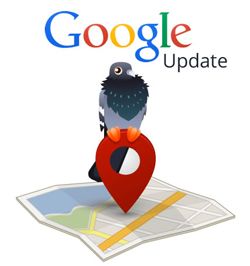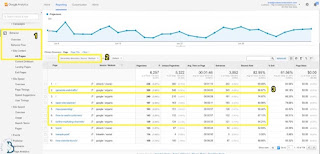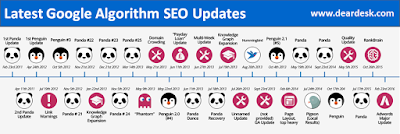History Of Search Engine Optimization
Search engine optimization SEO is a technique that used to mount the amount of visitors to a website by obtaining a high-ranking placement in the search results page of a search engine.
SEO has two major components, On Page Optimization and Off Page Optimization.
On Page Optimization
In On Page Optimization, modification/ Editing that can be taken directly within the website in order to improve its position in the search rankings.
Off Page Optimization
In Off Page Optimization, modification/ Editing that can be taken outside the website in order to improve its position in the search rankings.
It depends on another web page to improve your site or blog.
Elements of SEO
Google Search Engine work with three phases.
1) Crawling
2) Indexing
3) Ranking
Crawling is the process where Google visits our website for tracking purposes via Google crawler/ spider/ bot. Crawling means following your links and “crawling” around your website.
When bots come to your website,they follow other linked pages also on your website. The way we stop crawling certain parts of our site is by using the Robets.txt file.
The next phase is indexing, is the process of adding webpages into Google search. After a web page or document has been detected by crawlers, all its accessible data is stored (cached) on search engine servers so it can be retrieved when a user performs a search query.
If you don’t like to display particular webpage into Google search results, then you can use no-index header tags.
Ranking is done in real time. Once a keyword is entered, search engines will check for pages within their index that are a closest match. A score will be assigned to these pages based on an algorithm consisting of hundreds of different ranking signals.
These pages will then be displayed to the user in order of score. So in order for your site to rank well in search results pages, it's important to make sure search engines can crawl and index your site correctly - otherwise they will be unable to appropriately rank your website's content in search results.
SEO Practices
Basically there are 3 type of SEO practices.
Black Hat : They are unethical hackers, it is only focus on search engine and not a human audiences and doesn't obey search engine rule.
● Link farms
● Keyword stuffing
● Hidden text
● Blog spam
White Hat : White- hat hackers are the opposite of the black- hat hackers. They are ethical hackers. Websites which are using white hat techniques might not suddenly pop up on the search results, they get long lasting result when they finally do.
● Quality content
● Site optimization
Grey Hat : it stands between ethical and unethical activities.
- Growth hacking : Hack the benefits of other websites that having high rank.
Evolution Of Search Engine Optimization
1. Content Specification:
Using of same keywords more than the limit in webpages and using of unwanted keywords in blank space. This process is called Keyword Stuffing.
2. Link Specification :
Websites which get more links from other website is called link specification.
Google consider it has a recommendation.
3. Quality Link Specification :
Quality link specification is a process of using links that have quality websites. This is done by Google, by Ranking each website according to user’s visit. This is called Page Ranking.
10/10 Ranking website is most Quality Website. Examples are,
• US Government website
• Twitter
Page Ranking was stopped by Google in 2016.
Last Google Page Ranking updation was done on December 6,2013 and February 4,2013.
Passing The Juice : In this process, when a website that having high page rank gives links to websites that have low page rank, then automatically that high page ranking will be reduced to low page ranking.This is called Passing the juice
4. Google Adwords
Google Adwords is an advertisement program by Google for displaying ads on Google. This program set a budget for advertising and only pays when people click the ads.
The ad service is largely focused on keywords. Each keyword you choose will have a cost per click (CPC) amount. A higher CPC amount can allow your ad to show at a higher position on the page.
5. Google Adsense
 Google Adsense is also an advertisement program by Google where we can earn money. For that we need a good website/ YouTube channel that having more visitors/ subscribers. It helps advertisers create and publish advertisements on publisher’s websites or YouTube channel.
Google Adsense is also an advertisement program by Google where we can earn money. For that we need a good website/ YouTube channel that having more visitors/ subscribers. It helps advertisers create and publish advertisements on publisher’s websites or YouTube channel.
6. Pogo Sticking in SEO
Pogo sticking in SEO means when a user performs a search in Google and clicks on a result, then very quickly clicks back to the search result page, and clicks on a different result.
this type of behavior is direct result of immediate dissatisfaction in search result. That time Google rank the first result to low page ranking and second result to high page ranking.
7. Social Media Authority Value
In 2010, Google prefer more importance to Social Media. Maximum share the websites in social media. But later Google tells that interaction of user’s is more important than sharing. For example:
If two websites that having same interaction, then Google will rank up the website according to authority value, means it should be a celebrity, politician etc… So those who have more influence power get more interaction.
1. Google Panda update:
Google Panda Update was launched in February 2011. Google used Panda Update against Content Spamming. By using this update Google keep low quality content sites away from the top ranking results and give the actual quality sites first.
Methods :
• Duplicate content used
• Quality less content used
• Content spinning:
using of same paragraph in all other pages, just sentence change.
• Thinny pages:
website which have pages but less content.
After all this, many versions came under panda update, version 1, version 2…. etc
Among this, the most important version is version 4.0
Because this is permanently attached as a filter in the algorithm. So that when the content is passing through the algorithm and if there is any content duplication that time itself it will be removed.
2. Google Penguin update:
 Google Penguin Update was launched in April 2012. Google used Penguin Update against Link Spamming. Google used this update to bring the high quality and content sites on the top of search engine rankings.
Google Penguin Update was launched in April 2012. Google used Penguin Update against Link Spamming. Google used this update to bring the high quality and content sites on the top of search engine rankings.
Methods :
• Paid links
• Link exchange
• Directory submission: Directory submission is the process of listing your site to various directories or databases under the correct category or sub category.
• Link farming: Websites use link farming to boost their rankings in search engine results. Website enters a relationship of reciprocal linking with another site or pays a provider for a large number of inbound links.
• Comment spamming: Comment spamming means when a site have a blog in their website and there we comment for that blog with our website link. it’s called Comment spamming.
• Wicky spamming: It means applying our website links in Wikipedia. In Wikipedia, we can apply edition. Some webmasters register in Wikipedia and apply their website link there.
• Guest blogging: In 2011, 2012 some people invite other persons to written blog in their website. That time that person write blog and also apply a link in that blog to their website.
After all this, many versions came under Penguin update, version 1, version 2…. etc
Among this, the most important version is version 4.0
Because it’s a real time punishment,
that is whenever a link is submitted each link is catched at that time itself.
6. Parked Domain Update:
In 2012 April this update was done. Some people buy many domains at a time and kept some of them as parked domains. This is not useful for user’s. so Google bring this update to remove such domains from search engine.
6. Exact Match Domain Update [EMD] :
Google launched this update in September 2012. It’s a combination of keyword which the website in question is supposed to be optimized for. Exact match domains were a popular means for SEO to rank well and fast for a specific keyword.
7. Pirate Update:
This update was introduced in August 2012. Pirate update was designed to prevent sites with many copyright (content, image copy write from other webpage) through Google’s DMCA system.
DMCA(Digital Millennium Copyright Act) : We can compliant through Google, if someone Copy content or other materials from one website without their permission. When google analyse and accept compliant then remove that URL file from google.

Humming bird update started on 2013 and by using this update google make the search engine much better at answering specific user questions.
Google give more priority to user accepted fact. This is called semantic search result. if we search something like interactive or descriptive query, google gives a deep clarification about the results.
5. Rank Brain Update:
In 2015, Google introduced Rank Brain update. It is an advanced version of Humming bird update. It is implemented with a artificial intelligence program from Google.
8. Mobile Geddon:
Mobile geddon is a mobile friendly update. In 2016, April 21st Google introduced this. In this update mobile responsive sites have their page ranking high and not responsive sites have their page ranking low.
Here the websites should be mobile friendly ie textfileds are readable without zooming or tapping and tabs are correctly aligned.
3.Pigeon Update:
Pigeon update is related to local SEO audience. The update is used to increase the ranking of local listing in a search.For this local SEO process available,

ie like restaurants, hospitals their audience will be from their local area.
we have some steps :
1. mark place verify in google map
2. Give location address
3. Add our website in local directory
4. Geo tagging
5.Social media interaction get more from local area

















